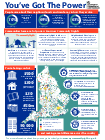Milestone reached as community rights uses hit 3,000
More than 1,500 buildings, assets and green spaces are listed and 1,200 neighbourhood plans are well underway.

Millions of people across England are now benefitting from the government’s community rights programme, coming together to protect pubs, libraries and leisure centres against sell off, creating neighbourhood plans to decide on new local development and deliver local jobs and improved local services.
The total number of uses of the rights has now hit 3,000, with more than 1,500 much loved buildings, assets and green spaces listed and 1,200 neighbourhood plans well underway.
See our new interactive community rights map to find out about listed buildings and other community rights uses in your area.
Communities Minister Stephen Williams said:
Governments in the past have sought to hold on to and centralise power, but we have broken this hold, trusting councils and local people to decide how to run their community and they have embraced this with more than 3,000 uses of the rights so far.
From regulars taking over their local pub to ambitious local plans for new development, new jobs and better targeted services, community rights are providing a very real local revolution.
Communities have a set of community rights powers. They include:
Community Right to Bid
Helps to protect treasured local community assets. Communities can nominate any local building or land they love as an ‘asset of community value’ and then, if it comes up for sale, they have 6 months to raise the funds to buy it.
More than 1,500 much loved assets are now listed including 500 pubs, 30 football stadiums, right through to Blencathra, one of the Lake District’s best-known peaks to the iconic cold-war era control tower at Greenham Common.
Neighbourhood planning
Enables local communities to shape the places where they live and work. Residents are directly able to decide what type of development is needed, where it should go and what it should look like.
More than 1,200 neighbourhood plans are underway, covering over 5 million people.
Community shares
Enable residents to invest financially in community projects. By buying shares and becoming part-owners of a business, local people can become supporters, volunteers and advocates, and projects get much needed funding to get started and become financially sustainable.
£50 million has been raised through community shares offers since 2012.
Our Place
Helps residents work together with councillors, service providers, businesses and voluntary and community organisations to solve local problems and improve local services.
Our Place ensures that public money is being spent in the ways local people want. Over 3 million people are now covered by the Our Place approach.
Tenant empowerment programme
Supports social housing tenants to engage in, manage or control local services. It provides training, funding and support that enables tenants to, for instance, manage a service, or take control of their housing through the Right to Manage.
People care about their neighbourhoods and want a say in how they evolve. Community rights are making this possible. For example:
-
the One Haverhill partnership in Suffolk pioneered the Our Place approach, creating 51 new apprenticeships with potential lifetime savings of at least £900,000
-
in Cringleford, Norfolk residents voted in favour of a neighbourhood plan allocating land for approximately 1,200 new homes
-
Writhlington Court residents in Somerset took on delivery of their gardening services from their landlord, resulting in savings which will go back to local residents
-
FC United of Manchester have raised £1.9 million to help build their new stadium through community shares; in Cornwall, Community Power Cornwall used community shares to fund the county’s first community owned renewables project
-
the Ivy House pub in south London was bought by the local community, saving it from redevelopment into flats
The infographic below shows the distribution of Community Rights across the country.
Further information
Want to get involved in your community? See the my community rights website for details on how to go about it.
For some further great case studies of communities taking control see our Pinterest board.
Community rights are enshrined in law by the Localism Act 2011. The first rights came into force on 6 April 2012.
People care about their neighbourhoods and want a say in how they evolve. Figures from the 2013 to 2014 Community Life Survey found that 70% of citizens have a strong sense of belonging to their neighbourhood, 69% of citizens think it is important for them personally to feel they can influence decisions and 63% of citizens say they would be more supportive of house building if local people were given greater control and say over what gets built.
The interactive map shows:
- listed assets of community value
- designated neighbourhood planning areas
- Our Place
- community shares
- Give it a Go starter grants
- designated tenant panels
- tenant management organisations
The data on assets of community value is based on the information obtained from lists of assets of community value, published on local authority websites, where available, at the time of production.
The data on designated tenant panels, tenant management organisations and community shares is collected by other organisations.
If you have any queries please let us know by emailing [email protected].
Office address and general enquiries
2 Marsham Street
London
SW1P 4DF
Email [email protected]
General enquiries: please use this number if you are a member of the public 030 3444 0000
If your enquiry is related to COVID-19 please check our guidance page first before you contact us - https://www.gov.uk/guidance/coronavirus-covid-19-guidance-for-local-government.
If you still need to contact us please use the contact form above to get in touch, because of coronavirus (COVID-19). If you send it by post it will not receive a reply within normal timescale.
Media enquiries
Email [email protected]
Please use this number if you are a journalist wishing to speak to Press Office 0303 444 1209

